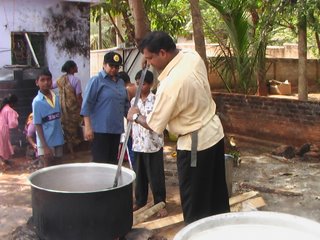
Kulfi is a popular Indian, frozen dairy based dessert. The texture, taste and the way it is prepared is almost similar to preparing ice cream but kulfi takes a longer time to melt. Kulfi is also never made with eggs, like French ice.
The traditional way of preparing kulfi is by boiling and reducing milk over slow fire and then sweetening it and flavouring it. When the milk thickens it increases the fat, protein and lactose density. A new taste is formed too – the lactose and sugar caramelizes due to slow cooking process. These days it is quite common for people to make kulfis with evaporated milk and condensed milk that is thickened with cornflour!
You can make kulfi in many flavours – saffron, mango, pistachio, cardamom, orange, almond, rose, avocado, green tea and any other flavor you fancy. The kulfi mixture is poured into cone shaped canisters and sealed. The canisters are placed in the freezer. You can also pour the kulfi mix into ice cube trays and then freeze it. There is no paddle in the canister to rotate, as is the case with making ice cream. Technically, Kulfi is still an ice cream but that does not need churning or whisking in between.
Since the kulfi expands as it freezes don't fill the canister or moulds more than two-thirds full. If frozen in individual-portion dessert bowls to be served with a spoon, the bowls are removed from the freezer 10-15 minutes before serving to allow for melting at the edges.
Traditionally in India, kulfi is sold by street vendors called Kulfiwallahs . Kulfiwallas place the cone-shaped moulds into large earthen pots, or “matka,” filled with ice and salt. When a kulfi is ordered, they simply pull the frozen treat from its mould and serve it on a plate, garnished with pistachios, cardamom or vermicelli.
In your next visit to Spice Queen, try the kulfi of the day!!
The traditional way of preparing kulfi is by boiling and reducing milk over slow fire and then sweetening it and flavouring it. When the milk thickens it increases the fat, protein and lactose density. A new taste is formed too – the lactose and sugar caramelizes due to slow cooking process. These days it is quite common for people to make kulfis with evaporated milk and condensed milk that is thickened with cornflour!
You can make kulfi in many flavours – saffron, mango, pistachio, cardamom, orange, almond, rose, avocado, green tea and any other flavor you fancy. The kulfi mixture is poured into cone shaped canisters and sealed. The canisters are placed in the freezer. You can also pour the kulfi mix into ice cube trays and then freeze it. There is no paddle in the canister to rotate, as is the case with making ice cream. Technically, Kulfi is still an ice cream but that does not need churning or whisking in between.
Since the kulfi expands as it freezes don't fill the canister or moulds more than two-thirds full. If frozen in individual-portion dessert bowls to be served with a spoon, the bowls are removed from the freezer 10-15 minutes before serving to allow for melting at the edges.
Traditionally in India, kulfi is sold by street vendors called Kulfiwallahs . Kulfiwallas place the cone-shaped moulds into large earthen pots, or “matka,” filled with ice and salt. When a kulfi is ordered, they simply pull the frozen treat from its mould and serve it on a plate, garnished with pistachios, cardamom or vermicelli.
In your next visit to Spice Queen, try the kulfi of the day!!












